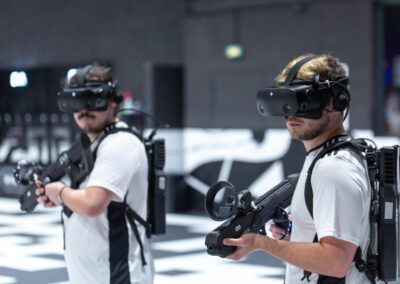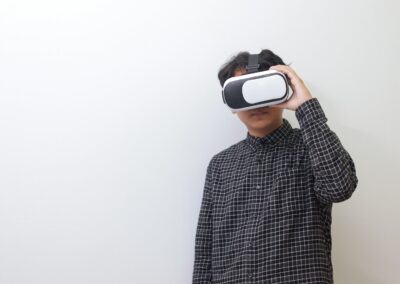Maximizing Revenue Potential in Virtual Reality Fitness Apps
The Growing Appeal of VR Fitness Programs
Virtual Reality (VR) fitness programs are revolutionizing the way people approach exercise and wellness. As the fitness industry increasingly embraces cutting-edge technology, VR fitness apps offer immersive and engaging workout experiences that attract a broad audience. This trend is particularly evident in technologically advanced markets such as Saudi Arabia and the UAE, where innovation is a key driver of economic growth and consumer interest.
VR fitness programs stand out by offering users a unique blend of exercise and entertainment. These applications create an immersive environment that makes workouts more enjoyable and motivating. For instance, users can engage in high-energy cycling through scenic virtual landscapes or participate in interactive fitness challenges that feel like a game. This level of engagement not only enhances the workout experience but also increases user retention and satisfaction.
Moreover, VR fitness programs cater to a wide range of fitness levels and preferences. Whether users are looking for intense cardio sessions or mindful yoga practices, VR fitness apps can provide customized experiences that meet individual needs. This versatility and personalization contribute to the growing popularity of VR fitness programs, making them an attractive option for both fitness enthusiasts and casual users.
Business Models for VR Fitness Programs
To successfully monetize VR fitness programs, developers must implement effective business models that align with user expectations and market trends. Several business models have proven effective in the VR fitness space, each offering unique revenue opportunities.
One prevalent business model is the subscription-based approach. This model allows users to access a range of VR fitness programs and content for a recurring fee. Subscriptions can be structured on a monthly or annual basis, providing a steady stream of revenue while offering users ongoing value. For example, a VR fitness app could offer a basic subscription tier with access to a limited selection of workouts and a premium tier with additional features such as personalized coaching, advanced metrics, and exclusive content.
Another effective monetization strategy is the freemium model, where the app is available for free with optional in-app purchases. This approach attracts a broad user base by offering core functionalities at no cost while providing opportunities for users to purchase additional features or content. In the context of VR fitness, this could include purchasing individual workout routines, virtual equipment, or advanced analytics. The freemium model allows users to experience the app’s value before committing to a purchase, which can drive higher conversion rates and revenue.
Partnerships and sponsorships also present lucrative revenue opportunities for VR fitness programs. By collaborating with fitness brands, equipment manufacturers, and wellness influencers, developers can generate additional income through sponsorship deals and co-branded content. For instance, a VR fitness app could partner with a popular sportswear brand to offer exclusive virtual workout gear or integrate branded fitness challenges. These partnerships not only create new revenue streams but also enhance the app’s credibility and appeal.
Maximizing Revenue Potential in VR Fitness
To maximize the revenue potential of VR fitness programs, developers need to focus on several key strategies that drive user engagement and retention. Continuous innovation, user-centric design, and effective marketing are essential for achieving long-term success in this competitive market.
First, leveraging data analytics to personalize the user experience can significantly enhance engagement and satisfaction. By analyzing user behavior, preferences, and performance metrics, developers can tailor content and recommendations to meet individual needs. For example, a VR fitness app could use data to suggest personalized workout plans or offer targeted challenges based on user goals and progress. This level of personalization not only improves the user experience but also encourages continued use and subscription renewals.
Second, integrating advanced technologies such as AI and machine learning can further enhance the functionality and appeal of VR fitness programs. AI-powered features like virtual personal trainers, real-time feedback, and adaptive workout adjustments can provide users with a more interactive and effective fitness experience. Additionally, incorporating social features such as leaderboards, group workouts, and virtual fitness communities can foster a sense of connection and competition, driving user engagement and retention.
Lastly, a robust marketing strategy is crucial for attracting new users and building a strong brand presence. Effective digital marketing campaigns, strategic partnerships, and influencer collaborations can help raise awareness and drive downloads. Offering limited-time promotions, referral bonuses, and special events can also incentivize users to try the app and share it with others. By building a strong user base and creating a compelling value proposition, developers can maximize their revenue potential and establish a leading position in the VR fitness market.
Conclusion
The business models and monetization strategies for VR fitness programs present significant opportunities for developers to generate revenue and grow their businesses. By adopting subscription-based and freemium models, forming strategic partnerships, and focusing on continuous innovation, developers can maximize their revenue potential and deliver exceptional value to users. In regions like Saudi Arabia and the UAE, where technological advancement and consumer demand for innovative solutions are high, VR fitness programs are well-positioned to thrive and shape the future of fitness.
—
#VRFitnessPrograms #MonetizationStrategies #VirtualRealityFitness #FitnessTech #RevenuePotential #FreemiumModel #SubscriptionFitness #FitnessInnovation #SaudiArabiaFitness #UAETech #RiyadhFitness #DubaiVRFitness























